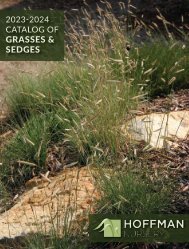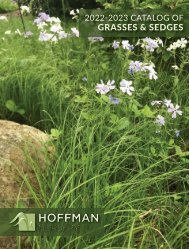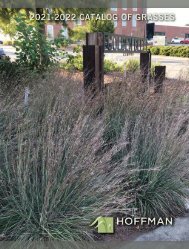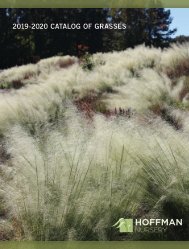2020-2021 Hoffman Nursery Catalog of Grasses
Create successful ePaper yourself
Turn your PDF publications into a flip-book with our unique Google optimized e-Paper software.
CAREX
CAREX COMPARISON CHART
Carex
C. oshimensis
EverColor ®
‘Everlime’
C. oshimensis
EverColor ®
‘Eversheen’
C. oshimensis
‘Evergold’
N. American
Native
Max Height
Zones
1’ 6-8
1’ 6-8
1’ 6-8
Blade Width
Color
Green
w/lime
margins
Lime yellow
w/green
margins
Yellow
w/green
margins
Characteristics/Habit
Bunching habit with full,
arching foliage; a good grower;
vivid tone-on-tone effect
Neat flowing habit with full,
arching foliage; a good grower
Bunching habit with full,
arching foliage; excellent
low ground cover
Exposure
Moisture
Shade
Part-shade
Part-sun
Sun
Dry
Average
Moist
Wet
Carex amphibola
Carex amphibola
CREEK SEDGE
This widely adaptable, native sedge has subtle
ornamental appeal with green foliage and a
tidy, bunching habit. Grows throughout the
eastern U.S. in a range of conditions and
remains semi-evergreen in milder climates.
Good for rain gardens, shade plantings, meadows,
banks, or a low-maintenance ground
cover. Tends to reseed. Also known as Eastern
Narrowleaf Sedge.
Cool season, green, 1’, 1.5’ with blooms, sun-shade,
wet-average, flowers late spring, Zones 3-9, Origin:
North America
CAREX
C. pensylvanica
C. plantaginea
C. rosea
C. ‘Silver
Sceptre’
C. squarrosa
1’
10”
14”
1’
3’
4-8
3-8
3-8
5-9
4-8
Green
Green
Green
C. scaposa 1’ 7-9 Green
Green
w/white
margins
Green
Forms carpet-like colonies;
excellent ground cover; takes
some sun with moist soil
Very attractive, dimpled
foliage; can reseed into
colonies
Bunching habit, short
rhizomes; similar appearance
to C. appalachica
Bunching habit w/short
rhizomes; showy, pink
blooms spring & fall
Spreads slowly via rhizomes;
good for shade
Bunching habit; plump,
spiky seed heads; tolerates
wet shade
Carex appalachica
APPALACHIAN SEDGE
A graceful, native sedge for masses, slopes,
and as a lawn alternative. With a bunching
habit, its narrow, foot-long foliage lies in a
sweeping mound 6” from the ground. Found
naturally in dry to mesic deciduous forests, it’s
best with some shade, particularly in warmer
regions. Prefers dry-average soil. Found primarily
in New England and southward down
the Appalachians.
Cool season, green, 10”, 12” with blooms, shadepart
shade, dry-average, flowers late spring, Zones
3-8, Origin: North America
Carex appalachica
C. stricta
C. testacea
‘Prairie Fire’
C. texensis
C. vulpinoidea
3’
1.5’
1’
3’
4-8
5-9
5-9
3-8
Blade
Width Fine Medium Broad
Green
Greenbronze
w/orange
tips
Green
Green
Large tussocks on wet sites,
more rhizomatous when drier;
tolerates seasonal flooding
Upright habit with arching
foliage; showy foliage tips
Bunching habit, no
conspicuous rhizomes; takes
sun with more moisture
Bunching; forms colonies
via rhizomes; competitive,
widespread species
Carex bicknellii
Carex bicknellii
BICKNELL’S SEDGE
This native sedge grows in tufts of green, narrow
foliage. Copper, oval-shaped seed heads
appear in spring. Tolerates dry soil better than
many sedges; useful for rain gardens, slopes,
and meadow plantings. Found primarily in the
upper Midwest south to Kansas in dry and
moist prairies, open woodlands, and rocky
areas.
Cool season, green, 1.5’, 3’ with blooms, sun-part
shade, wet-dry, flowers early spring, Zones 3-7,
Origin: North America
32 We grow good grass! ® 1-800-203-8590 hoffmannursery.com
33










